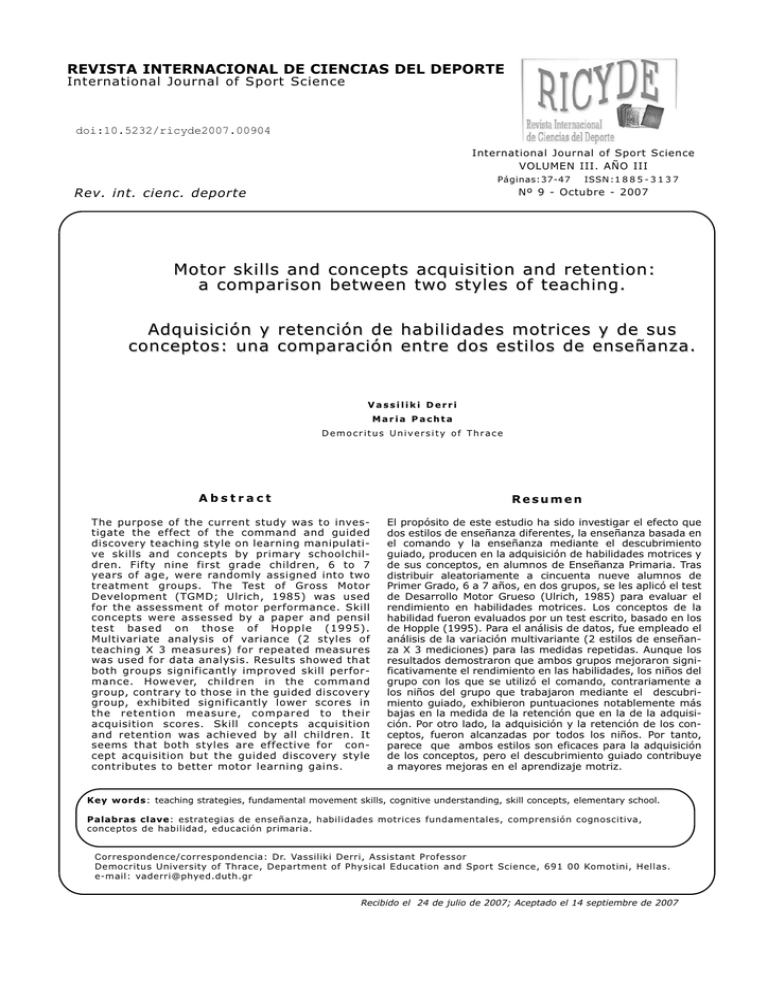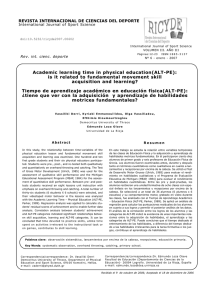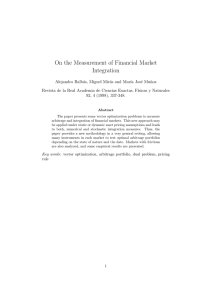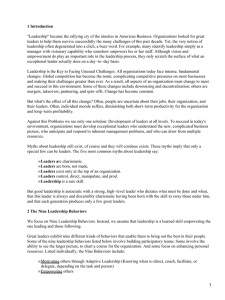Motor skills and concepts acquisition and retention
Anuncio

REVISTA INTERNACIONAL DE CIENCIAS DEL DEPORTE International Journal of Sport Science doi:10.5232/ricyde2007.00904 International Journal of Sport Science VOLUMEN III. AÑO III Páginas:37-47 Rev. int. cienc. deporte ISSN :1 8 8 5 - 3 1 3 7 Nº 9 - Octubre - 2007 Motor skills and concepts acquisition and retention: a comparison between two styles of teaching. Adquisición y retención de habilidades motrices y de sus conceptos: una comparación entre dos estilos de enseñanza. Vassiliki Derri Maria Pachta Democritus University of Thrace Abstract Resumen The purpose of the current study was to investigate the effect of the command and guided discovery teaching style on learning manipulative skills and concepts by primary schoolchildren. Fifty nine first grade children, 6 to 7 years of age, were randomly assigned into two treatment groups. The Test of Gross Motor Development (TGMD; Ulrich, 1985) was used for the assessment of motor performance. Skill concepts were assessed by a paper and pensil test based on those of Hopple (1995). Multivariate analysis of variance (2 styles of teaching X 3 measures) for repeated measures was used for data analysis. Results showed that both groups significantly improved skill performance. However, children in the command group, contrary to those in the guided discovery group, exhibited significantly lower scores in the retention measure, compared to their acquisition scores. Skill concepts acquisition and retention was achieved by all children. It seems that both styles are effective for concept acquisition but the guided discovery style contributes to better motor learning gains. El propósito de este estudio ha sido investigar el efecto que dos estilos de enseñanza diferentes, la enseñanza basada en el comando y la enseñanza mediante el descubrimiento guiado, producen en la adquisición de habilidades motrices y de sus conceptos, en alumnos de Enseñanza Primaria. Tras distribuir aleatoriamente a cincuenta nueve alumnos de Primer Grado, 6 a 7 años, en dos grupos, se les aplicó el test de Desarrollo Motor Grueso (Ulrich, 1985) para evaluar el rendimiento en habilidades motrices. Los conceptos de la habilidad fueron evaluados por un test escrito, basado en los de Hopple (1995). Para el análisis de datos, fue empleado el análisis de la variación multivariante (2 estilos de enseñanza X 3 mediciones) para las medidas repetidas. Aunque los resultados demostraron que ambos grupos mejoraron significativamente el rendimiento en las habilidades, los niños del grupo con los que se utilizó el comando, contrariamente a los niños del grupo que trabajaron mediante el descubrimiento guiado, exhibieron puntuaciones notablemente más bajas en la medida de la retención que en la de la adquisición. Por otro lado, la adquisición y la retención de los conceptos, fueron alcanzadas por todos los niños. Por tanto, parece que ambos estilos son eficaces para la adquisición de los conceptos, pero el descubrimiento guiado contribuye a mayores mejoras en el aprendizaje motriz. Key words: teaching strategies, fundamental movement skills, cognitive understanding, skill concepts, elementary school. Palabras clave: estrategias de enseñanza, habilidades motrices fundamentales, comprensión cognoscitiva, conceptos de habilidad, educación primaria. Correspondence/correspondencia: Dr. Vassiliki Derri, Assistant Professor Democritus University of Thrace, Department of Physical Education and Sport Science, 691 00 Komotini, Hellas. e-mail: [email protected] Recibido el 24 de julio de 2007; Aceptado el 14 septiembre de 2007 Derri, V.; Pachta, M. (2007). Motor skills and concepts acquisition and retention: a comparison between two styles of teaching. Revista Internacional de Ciencias del Deporte. 9(3), 37-47 http://www.cafyd.com/REVISTA/00904.pdf Introduction L earning to move, through motor skill acquisition and physical fitness enhancement, and b) learning through movement, by developing social skills and cognitive concepts, are essential goals of a developmentally appropriate physical education program (Gallahue & Cleland, 2003). Besides, National standards have been generated in many countries to enable the achievement of the above goals (i.e. National Association for Sport and Physical Education; NASPE, 2007). Acquiring mature patterns of fundamental movement skills during early childhood is necessary for successful participation in games and sports (i.e. Graham, 1991; Rink, 2002). It also provides children with physical, social, and emotional benefits that may encourage a more active and healthy lifestyle in the present (Caine & Caine, 1991) and in the future (Barton, Fordyce & Kirby, 1999). Motor skill learning is an active process, interrelated with cognition. Skill concepts are aspects of cognitive concept learning in physical education that focus on learning the way the body should move while performing motor skills (Gallahue & Cleland, 2003). The development of such a knowledge base facilitates children’s motor engagement, decreasing errors in performance both in- and out of the school setting. Children have the potential to learn fundamental movement skills and the respective skill concepts by the age of seven if they receive instruction and encouragement, by the physical education teacher (i.e. Graham, Holt/Hale & Parker, 2003). The broad goals of physical education, the characteristics of children and the increasing awareness of why and how children learn through the movement activities have significantly influenced teaching in physical education (Kirchner & Fishburne, 1998). The teaching styles, that is the strategies for organizing and presenting learning experiences to children (Nichols, 1994) have received considerable attention within the educational literature over the past two decades as they provide information about teacher effectiveness (i.e. Aitkin & Zuzovsky, 1994) and student learning (i.e. Wentzel, 2002). Therefore, effective physical education teachers are expected to master a repertoire of teaching styles to foster student learning in all the dimensions of physical education, and to assist them to meet the school program standards (Garn & Byra, 2002; Joyce & Weil, 1986). Mosston’s Spectrum of Teaching Styles (Mosston & Ashworth, 2002) is perhaps the most comprehensive framework which has been applied and refined for over 30 years. In its current version, the command (A), practice (B), reciprocal (C), self check (D), and inclusion (E) styles are related to direct instruction. Through them knowledge is reproduced (reproductive group of styles) as the teacher is responsible for the majority of the instructional decisions while the learner acquires knowledge and skill by following them. In contrast, guided discovery (F), convergent discovery (G), divergent production (H), learner’s individual designed program (I), learner initiated (J), and self teaching (K) styles aim to produce new knowledge (productive group of styles) by involving the learner in the learning process. The productive styles are similar to the Socratic Method used in Ancient Greece 2500 years ago, and are used when the goal is 38 Derri, V.; Pachta, M. (2007). Motor skills and concepts acquisition and retention: a comparison between two styles of teaching. Revista Internacional de Ciencias del Deporte. 9(3), 37-47 http://www.cafyd.com/REVISTA/00904.pdf related to critical thinking, discovery or exploration of movement, and problem solving (Hall & McCullick, 2002). Many studies were conducted in an attempt to discover relationships between different teaching styles and student learning. In an overview of research findings from the last 30 years related to the two different groups of styles, Byra (2000) found that it is the reproductive group which has been most commonly researched, with the exception of the self check style. In a series of studies with fifth graders (Goldberger, 1983; Goldberger & Gerney, 1986) and high school students (Goldberger, Gerney & Chamberlain, 1982), the effects of the practice, reciprocal, and inclusion styles on hockey skill acquisition, cognitive understanding and social development of the students were compared. The authors concluded that although all three styles resulted in significant performance improvement, the practice style produced better knowledge gains while the reciprocal style enhanced social interaction among students. Studies conducted by Boyce (1992) and Beckett (1990) seem to support the above findings. Boyce (1992) investigated the effect of command, practice, and inclusion styles with university students on a rifle shooting skill and found the command and practice styles superior to the inclusion style for the acquisition and retention of the skill. Also, Beckett (1990) concluded that both the practice and inclusion teaching style were effective in improving a soccer juggling skill by college students. Similarly, Harrison, Fellingham, Buck and Pellett (1995) applying the command and the practice style in college students to teach volleyball skills indicated that both were effective in terms of the percentage of successful trials. Moore (1996) studying the effect of practice and reciprocal style in improving volleyball skills of fifth grade students concluded that neither style proved to be superior to the other in helping students acquire the skills of overhand serving and forearm passing. Hein and Kivimets (2000) examined the effects of direct and indirect teaching on motor skill acquisition by fifth grade children. The learning outcome of the treatment groups revealed that the direct method was more acceptable than the indirect for teaching a motor skill like cartwheel. In contrast with the reproductive styles, the productive have been investigated in fewer studies. For example, Salter and Graham (1985) studied the effect of the command, guided discovery, and no instruction on a novel golf task acquisition, on cognitive understanding related to the performance of the motor skill, and on self-efficacy of elementary school students (3rd-6th grade). Their findings indicated no significant differences between the three groups neither in skill nor in self-efficacy. However, cognitive understanding was only improved with the command and guided discovery style, even after a 20-minute instruction. Investigating the effects of a combined command and practice style and the divergent problem solving style on elementary school students’ divergent movement ability, Cleland (1994) found that students in the latter group were superior both to those in the former and in the control group. Similarly, Goldberger (1995) indicated that students in the divergent problem solving group exhibited better ability to identify key aspects of the problem, to search for new solutions, and to judge if more information was needed. 39 Derri, V.; Pachta, M. (2007). Motor skills and concepts acquisition and retention: a comparison between two styles of teaching. Revista Internacional de Ciencias del Deporte. 9(3), 37-47 http://www.cafyd.com/REVISTA/00904.pdf The student-centered (indirect) styles were also proved more effective than the teachercentered (direct) by Morgan (2002), who studied the effect of the command, practice, reciprocal and guided discovery style on skill learning and on motivation climate. Although insightful, studies presented inconclusive results with regard to physical education. This could be attributed to the variety of skills and student ages, the short duration of the intervention programs (i.e. Pieron, 1995), and the performance versus the learning issue (i.e. Lee, 1991). It also seems to be true that a) research has often focused on student psychomotor acquisition, and especially on sport skills acquisition, ignoring the cognitive and social dimensions, despite their importance in learning (Beckett, 1990), and b) skill acquisition has been more related with direct styles such as the command (Boyce, 1992) because the teacher has a specific task to teach (e.g. ball catching) and the qualitative elements should be often emphasized (Ratliffe & Ratliffe, 1990), especially in the initial stages of instruction (Cleland & Pearse, 1995). On the other hand, there is still very little empirical evidence for the guided discovery teaching style in physical education (Blitzer, 1995; Mawer, 1999; McBride, Gabbard & Miller, 1990). This particular style can also be used to teach a specific task in the initial stages of instruction, and is considered most suitable for older preschoolers and primary-grade students. It is also suggested for the cognitive development and especially of critical thinking since it requires evaluation, analysis, and decision making (Garn & Byra, 2002). According to Pica (1995), with guided discovery children not only learn skills but they learn how to learn. To analyze the effect of the command and the discovery style of teaching on skill and concept learning, the following questions were posed as framework of the study: a) Which style is the best for skill acquisition and retention? b) Which style is the best for concept acquisition and retention in first grade children? Therefore, this study was conducted in an attempt to investigate the effect of the command and guided discovery teaching styles on fundamental manipulative skills and on respective skill concepts acquisition and retention in first grade children. Based on the research findings, it was hypothesized that a) the command teaching style would be more effective than the guided discovery style in the motor domain, and b) the guided discovery style would produce more knowledge gains than the command style. Method Participants Fifty-nine first grade children (34 boys και 25 girls), 6 to 7 years of age participated in the current study. Schools were randomly selected from a greater sample located in Northern Greece. Once permissions were obtained from the elementary school principals, physical education teachers, and parents, children were randomly divided into two groups. Group A (n=31) was taught skills and concepts through the command style of teaching while group B (n=28) with the guided discovery style. 40 Derri, V.; Pachta, M. (2007). Motor skills and concepts acquisition and retention: a comparison between two styles of teaching. Revista Internacional de Ciencias del Deporte. 9(3), 37-47 http://www.cafyd.com/REVISTA/00904.pdf Measures Motor assessment. The Test of Gross Motor Development (Ulrich, 1985) was applied for the qualitative assessment of the fundamental manipulative skills (throw, catch, kick, strike, and dribble). Each skill included three or four components which described its mature pattern and served as performance criteria. Children were tested individually and encouraged to give maximum effort. Each child performed three trials for each skill. All the movement tests were videotaped for further analysis by two observers who were trained according to the procedure followed by Graham (1991). After reviewing the criteria, the observers analysed a practice videotape and then a criterion videotape developed by experts in physical education. After obtaining a score of 90.3% aggreement for each performance criterion, observers were tested on intraobserver reliability. Specifically, after ten days they were required to do a second analysis of the same videotape for the determination of the intraobserver reliability. When an 88.590.5% agreement was obtained for each performance criterion, they started coding the actual videotapes which were collected for this study. When a criterion performance was correct two out of three times in the child’s performance, “1” grade was recorded in the recording sheet. However, when a criterion was not observed or was used inappropriately two out of three times, a “0” was marked. Thus, depending on the skill, a perfect score would be 4 (throw, catch, kick, strike) or 3 (dribble), if all performance criteria were performed correctly two out of three times, while the total score would be 19 points. Skill concepts assessment. For the assessment of the cognitive understanding, a paper and pencil test was created, based on those designed by Hopple (1995) for these ages. Specifically, students were required a) to match the picture of each manipulative skill with the correct word and b) to circle, among two pictures for each skill, that with the correct skill performance. For instance, in the picture with the erroneous throwing performance the legs of the child were in a parallel position. The best score for the test was 10 points. For the reliability of the test, a retest measure was applied one week after the test measure and data analysis showed that the intraclass correlation coefficient was high (ICC=.87). The test has logical validity and good internal consistency (Cronbach’s a =.72) The Programs Two different 10-week programs were applied twice per week for 40 minutes by the same physical education teacher; one of the authors of this study with specialization in teaching early young children. Twenty lesson plans were prepared for each one of the teaching conditions, based on the principles of the Mosston and Ashworth (2002) spectrum of teaching styles. Children in group Α followed the command style of teaching to improve skill and cognitive understanding. After demonstrating the skill, and emphasizing its qualitative cues, the physical education teacher provided to this group feedback and instruction when necessary. Children in group Β were taught the manipulative skills following the guided discovery style of teaching. In this case, the physical education teacher provided no demonstration of the skill, but guided children 41 Derri, V.; Pachta, M. (2007). Motor skills and concepts acquisition and retention: a comparison between two styles of teaching. Revista Internacional de Ciencias del Deporte. 9(3), 37-47 http://www.cafyd.com/REVISTA/00904.pdf to decide the correct way in order to perform the skill. Tasks for this group were designed in a way that allowed children to experiment with the movement, to make comparisons among their motor responses, and decide the best way to perform each part of each skill. The tasks used during the intervention were based on those of Pangrazi (2001), Graham, Holt/Hale and Parker (2003) and Hopple (1995), and the sequence was based on children’s motor development (Gallahue & Cleland, 2003). Results Means and standard deviations on all measures of both groups are depicted in Table 1. In the absence of significant differences between groups in the pre-test measure both on motor skill (F1,57=1.72, p>.05) and on cognitive understanding (F1,57=.02, p>.05), the multivariate analysis of variance for repeated measures [2 styles (guided discovery, command) Χ 3 measures (pre- post- retention test)] was applied to examine the prepost- and retention test differences (factor “measure”) between groups (factor “instruction”). Table 1. Means and standard deviations on all measures of both groups. Variables Manipulative skills Skill concepts Pre-test M SD Group A (command) Post-test Retention test M SD M SD Group B (guided discovery) Pre-test Post-test Retention test M SD M SD M SD 6.64 2.36 15.64 2.68 14.43 2.90 7.59 2.55 14.56 3.12 13.78 3.53 6.23 1.76 8.42 1.57 7.81 1.38 6.14 2.24 8.68 1.54 8.29 1.33 For motor skill acquisition and retention, results showed that the instruction X measure interaction was significant (F1,53=4.37, p<.05) (Figure 1). Bonferroni post hoc analysis showed that children in both groups improved their performance in the post-test measure (p<.001). Also, although both groups performed better in the retention test than in the pre test (p<.001), group B (guided discovery) contrary to group A (command), showed no significant decrement between post- and retention test performance (p>.05). 18 15,64 16 14,43 14 14,56 grade 12 10 13,78 7,59 8 6 6,64 Group A 4 Group B 2 0 Pre-test Post-test Retention test Figure 1. Interaction between the factors “measure” and “instruction” on manipulative skill acquisition and retention. 42 Derri, V.; Pachta, M. (2007). Motor skills and concepts acquisition and retention: a comparison between two styles of teaching. Revista Internacional de Ciencias del Deporte. 9(3), 37-47 http://www.cafyd.com/REVISTA/00904.pdf With regard to skill concept acquisition and retention, only the effect of the factor “measure” was significant (F1,57=68, p<.001). Pairwise comparisons showed significant differences between pre- and post test (p<.001), post and retention test (p<.001), and pre- and retention test perfromance (p<.001). Students acquired the skill concepts but they lowered their perfromance in the retention measure. Discussion Physical education curriculum objectives require teachers to be aware of and apply different teaching strategies in order to enhance student performance and achieve learning in the motor, the cognitive and the social domain. The present study attempted to investigate the effect of the command and guided discovery teaching styles on acquisition and retention of manipulative skills and respective concepts by first grade children. Although both teaching styles contributed to skill acquisition, with regard to retention, children in the command group (group A), contrary to those in the guided discovery group (group B) significantly lowered their performance from post- to retention test measure. This means that practice with the guided discovery style is more effective than practice with the command teaching style for motor skill learning. It seems that with the guidance of the teacher, experimentation, analysis, and problem solving assist children of this age to understand better the interconnection of the parts of each skill and achieve the learning goals. Apart from this, problem solving reduces fear of failure (Pica, 1995). The above finding leads to the rejection of the first hypothesis of this study, that the command teaching style would be more effective than the guided discovery style in the motor domain. Similarly, Salter and Graham (1985) and Byra (2000) revealed no significant differences between the command and the guided discovery teaching style on skill acquisition by elementary school students. Research has indicated that programs which are oriented on the development of manipulative skills improve these skills (Marshall & Bouffard, 1997), and that experience is an important factor of development (Kuhlman & Beitel, 1992). Also, McKenzie, Alcaraz, Sallis and Faucette (1998) suggest that the acquisition of the manipulative motor skills from early childhood gives children the opportunity to perform later more complex sport and game movements. With regard to the skill concepts acquisition and retention, group B gave more correct responses in the paper and pencil test both in the acquisition and in the retention phase but its performance was not significantly superior to that of group A. Therefore, the second hypothesis that the guided discovery style would produce more knowledge gains than the command style was not verified. Specifically, children in both groups showed similar progress from pre- to post- and from post- to retention measures. This result may be attributed to the fact that the cognitive part was related to skill concepts learning rather than movement exploration or strategies development. It is possible that if that was the target, results would be different. It has been stated that the use of questioning assists the critical thinking process (Schwager & Labate, 1993), but divergent questions are considered more effective than convergent questions (Miller, 1987). Similar were the findings of Byra (2000) and Salter and Graham (1985) who supported the effectiveness of both the command and the guided discovery teaching style in cognitive understanding of elementary school students, even after a 20-minute instruction. 43 Derri, V.; Pachta, M. (2007). Motor skills and concepts acquisition and retention: a comparison between two styles of teaching. Revista Internacional de Ciencias del Deporte. 9(3), 37-47 http://www.cafyd.com/REVISTA/00904.pdf However, although children in the present study improved their congnitive understanding after participating in the intervention programs, they were unable to retain practice gains. The importance of movement in the cognitive development of infants and young children, but also the dependence of motor development on intellectual abilities has been highlighted (Payne & Isaacs, 1995). Therefore, it would be expected that the guided discovery group would also have learned the skill concepts. It seems that both teaching styles can be applied when the goal is to teach skill concepts in children of this age but more research is needed to identify the factors that are related to the retention of the knowledge gains. In short, the findings of the present study indicate that different teaching styles can be effective for movement skill and concepts acquisition. However, contrary to the command style of teaching, the guided discovery style results in motor learning gains. These findings are quite different from other studies, which mentioned how effective are the direct teaching styles on the skill acquisition (Boyce, 1992), and from what Ratliffe and Ratliffe (1990) suggested that when the teacher has a specific goal, direct styles should be used, as the qualitative elements should be often emphasized. While in the past the researchers’ interest was focused on identifying the more effective teaching style, recently the viewpoint that each style assists in the achievement of different goals is supported. Therefore, effective physical education teachers should recognize the potential value of both direct and indirect styles of teaching and should be trained to use a variety of them to achieve the physical education goals in the early school years (Hein & Kivimets, 2000). A general recommendation on the selection and use of teaching styles would be to focus on the learner’s stage of motor development, the level of movement skill learning, and the ability of the learner to comply with the requirements of the task (Harrison, et al., 1995). In addition, given the children’s need for practice opportunities and specific feedback to develop motor skills (Kraft, Smith & Buzby, 1997) and skill concepts, it is important for the teachers to recognize the performance criteria in order to provide them appropriate learning experiences. Although specific approaches have been generally considered more appropriate for the achievement of different learning goals (e.g. direct instruction for motor learning, guided discovery for cognitive learning, peer teaching and cooperation for social learning), the findings of this study suggest that studies including longer interventions and measurement of learning are necessary. Further research a) on the transfer effects of the command and the guided discovery styles or of different teaching styles in real play situations, b) on the application of teaching styles to improve more complex cognitive functions and achieve cognitive learning, and c) on the relation between what teachers apply and discover through the use of different styles and research findings, would provide important evidence for instruction and student multifaceted learning in physical education. 44 Derri, V.; Pachta, M. (2007). Motor skills and concepts acquisition and retention: a comparison between two styles of teaching. Revista Internacional de Ciencias del Deporte. 9(3), 37-47 http://www.cafyd.com/REVISTA/00904.pdf References Aitkin, M. & Zuzovsky, R. (1994). Multilevel interaction models and their use in the analysis of large-scale school effectiveness studies. School Effectiveness and School Improvement 5, 45-73. Barton, G. V.; Fordyce, K. & Kirby, K. (1999). The importance of development of motor skills to children. Teaching Elementary Physical Education, 10(4), 9-11. Beckett, K. (1990). The effects of two teaching styles on college students achievement of selected physical education outcomes. Journal of Teaching in Physical Education, 10, 153-169. Blitzer, L. (1995). It’s a gym class…What’s there to think about? Journal of Physical Education, Recreation and Dance, 66(6), 44-48. Boyce, B. A. (1992). The effects of three styles of teaching on university students’motor performance. Journal of Teaching in Physical Education, 11(4), 389-401. Byra, M. (2000). A review of spectrum research: The contributions of two eras. Quest 52, 229–245. Caine, R.N. & Caine, G. (1991). Making Connections: Teaching and the human brain. Alexandria, VA: Association for Supervision and Curriculum Development. Cleland, F. E. (1994). Young children’s divergent movement ability: Study II. Journal of Teaching in Physical Education, 13(3), 228-241. Cleland, F. E. & Pearse, C. (1995). Critical thinking in middle school physical education: reflections on a yearlong study. Journal of Physical Education, Recreation and Dance, 66(6), 31-38. Gallahue, D.L. & Cleland, F.E. (2003). Developmental physical education for all children. USA: Human Kinetics. Garn, Α. & Byra, Μ. (2002). Psychomotor, cognitive and social development spectrum style. Teaching Elementary Physical Education, 13, 7-13. Goldberger, M. (1983). Direct styles of teaching and psychomotor performance. In T.J. Templin & J.K. Olson (Eds.), Teaching in Physical Education. Champaign, IL: Human Kinetics. Pp 211-223. Goldberger, M. (1995). Research on the spectrum of teaching styles. In R. Lidor, E. Eldar, and I. Harari (Eds.), Windows to the future: bringing the gaps between disciplines, curriculum and instruction. Proceedings of the 1995 AIESEP World Congress Part 2, Wingate Institute for Physical Education and Sport, Israel. Pp 429-435. Goldberger, M.; Gerney, P. & Chamberlain, J. (1982). The ffects of three styles of teaching on the psychomotor performance and social skill development of fifth grade children. Research Quarterly for Exercise and Sport, 53(2), 116-124. Goldberger, M. & Gerney, P. (1986). The effects of direct teaching styles on motor skill acquisition of fifth grade children. Research Quarterly for Exercise and Sport, 57, 215-219. Graham, G. (1991). Results of motor skill testing. Journal of Teaching in Physical Education, 10, 353-374. Graham, G.; Holt/Hale, A.; S. & Parker, M. (2003). Children Moving: A reflective approach to teaching physical education (6th Edition). USA: McGraw- Hill. 45 Derri, V.; Pachta, M. (2007). Motor skills and concepts acquisition and retention: a comparison between two styles of teaching. Revista Internacional de Ciencias del Deporte. 9(3), 37-47 http://www.cafyd.com/REVISTA/00904.pdf Hall, T. J. & McCullick, B. A. (2002). Discover, design, and invent: divergent production. Teaching Elementary Physical Education, 13(7), 22-24. Harrison, J. M.; Fellingham, G. W.; Buck, M. M. & Pellett, T. L. (1995). Effects of practice and command styles on rate of change in volleyball performance and self-efficacy of high-, medium-, and low-skilled learners. Journal of Teaching in Physical Education, 14(3), 328-339. Hein, V. & Kivimets, M. (2000). The effects of two styles of teaching and teachers qualification on motor skill performance of the cartwheel. Achta Kinesiologiae Universitatis Tartuensis (Tartu), 5, 67-78. Hopple, C. J. (1995). Teaching for Outcomes in Elementary Physical Education. A Guide for Curriculum and Assessment. Champaign, IL: Human Kinetics. Joyce, B. & Weil, M. (1986). Models of teaching (3rd ed.). Englewood Cliffs, NJ: Prentice Hall. Kirchner, G. & Fishburne, G. J. (1998). Physical education for elementary school children (10th ed.). McGraw-Hill. Kraft, R.; Smith, J. & Buzby, J. (1997). Teach Throwing and Catching to Large Classes. A Journal of Physical and Sport Educators, 10 (3), 12-23. Kuhlman, J. & Beitel, P. (1992). Coincidence anticipation: possible critical variables. Journal of Sport Behavior, 15, 91-105. Lee, A. (1991). Research on teaching in physical education: Questions and comments. Journal of Teaching in Physical Education, 62(4), 374-379. Marshall, J. D. & Bouffard, M. (1997). The effects of quality daily physical Education on movement competency in obese versus non obese children. Adapted Physical Activity Quarterly (Champaign, Ill.), 14(3), 222-237. Mawer, M. (1999). Teaching styles and teaching approaches in physical education: research and developments. In C.A. Hardy & M. Mawer (Eds.), Learning and teaching in physical education. Great Britain: Falmer Press, Taylor and Francis Group. McBride, R.; Gabbard, C. & Miller, G. (1990). Teaching critical thinking skills in the psychomotor domain. The Clearing House, 63, 197-201. McKenzie, T. L. ; Alcaraz, J. E. ; Sallis, J. F., & Faucette, F. N. (1998). Effects of a physical education program on children’s manipulative skills. Journal of Teaching in Physical Education, 17(3), 327-341. Miller, D. M. (1987). Energizing the thinking dimension of physical education. Journal of Physical Education, Recreation and Dance, 58(8), 76-85. Moore, R. E. (1996). Effects of the use of two different teaching styles on motor skill acquisition of fifth-grade students. Thesis (Ed. D.), East Texas State University. Morgan, K. (2002). What is “best practice” in teaching? Pedagogical style and motivation. The European Journal of Physical Education, 4, 31-44. Mosston, M. & Ashworth, S. (2002). Teaching physical education. (5th ed). NY: Benjamin Cummings. NASPE (2007). Moving into the future. National standards for physical education. USA: McGraw-Hill. Nichols, B. (1994). Moving and Learning. The Elementary School Physical Education Experience. USA: Mosby. 46 Derri, V.; Pachta, M. (2007). Motor skills and concepts acquisition and retention: a comparison between two styles of teaching. Revista Internacional de Ciencias del Deporte. 9(3), 37-47 http://www.cafyd.com/REVISTA/00904.pdf Pangrazi, R. (2001). Dynamic physical education for elementary school children. Boston: Allyn and Bacon. Payne, V. G. & Isaacs, L. D. (2007). Human motor development: A lifespan approach (7th ed.). NY: McGraw-Hill. Pica, R. (1995). Exploration, guided discovery, and the direct approach. A look at developmentally appropriate teaching styles. Teaching Elementary Physical Education, 6, 1,4-5. Pieron, M. (1995). Research on the spectrum of teaching styles. In R. Lidor, E. Eldar, and I. Harari (Eds.), Windows to the future: bringing the gaps between disciplines, curriculum and instruction. Proceedings of the 1995 AIESEP World Congress Part 2, Wingate Institute for Physical Education and Sport, Israel. Pp. 436-438. Ratliffe, T. & Ratliffe, L. (1990). Examining skill development in physical education classes: Science on a shoestring. The Physical Educator, 47(1), 37-47. Rink, J.E. (2002). Teaching Physical Education for Learning. NY: McGraw-Hill. Salter, W. B. & Graham, G. (1985). The effects of three disparate instructional approaches on skill attempts and student learning in an experimental teaching unit. Journal of Teaching in Physical Education, 4(3), 212-218. Schwager, S. & Labate, C. (1993). Teaching for critical thinking in physical education. Journal of Physical Education, Recreation and Dance, 64(5), 24-26. Ulrich, D. (1985). Test of Gross Motor Development. Austin, T.X: Pro-Ed. Wentzel, K. R. (2002). Are effective teachers like good parents? Teaching styles and student adjustment in early adolescence. Child Development, 73, 287-301. 47





